Flutter vs Xamarin: Which One to Choose?
Cross-platform mobile app development has become increasingly popular, resulting in the emergence of several new frameworks and solutions. Xamarin and the Flutter are two examples. In this post, we’ll take a quick look at Flutter vs Xamarin analysis and explain why they’re both great options to develop mobile apps.
Xamarin is a set of tools and frameworks for .NET developers that allows them to create applications for several platforms but Flutter’s sophisticated compositing features allow you to easily stack all the technical work.
To cut your confusion, in this post, learn how these frameworks may benefit your job and why they are a smart choice.
1. What is Flutter?
Google’s Flutter is a software development kit (SDK) for making cross-platform mobile, web, and desktop user interfaces with a uniform design and codebase. In addition to being open source, free, and utilized by web development companies and businesses across the globe, Flutter also makes it easy to reuse previous work.
Whether you’re developing iOS or Android apps, websites, windows apps, Linux apps, or integrating it as the UI toolset for a system, Flutter will enable you to create attractive, speedy applications with a profitable, adaptable, and open development paradigm.
Flutter is a mobile UI framework that provides a fast and expressive way for developers to build native apps on both iOS and Android
— Flutter (@FlutterDev) February 23, 2018
Learn 3 ways Flutter will help you from day 1 with this video → https://t.co/8u66qiAQVH pic.twitter.com/7sueMOiwMc
As mentioned earlier, Flutter’s sophisticated compositing features allow you to easily stack and animate visuals, movies, writing, and interfaces, and the framework’s layered design allows you to take complete control over each pixel on the display. Whether you’re developing for iOS (Cupertino) or another platform (Material), Flutter provides a comprehensive collection of widgets that can be customized or created from scratch to provide pixel-perfect experiences.
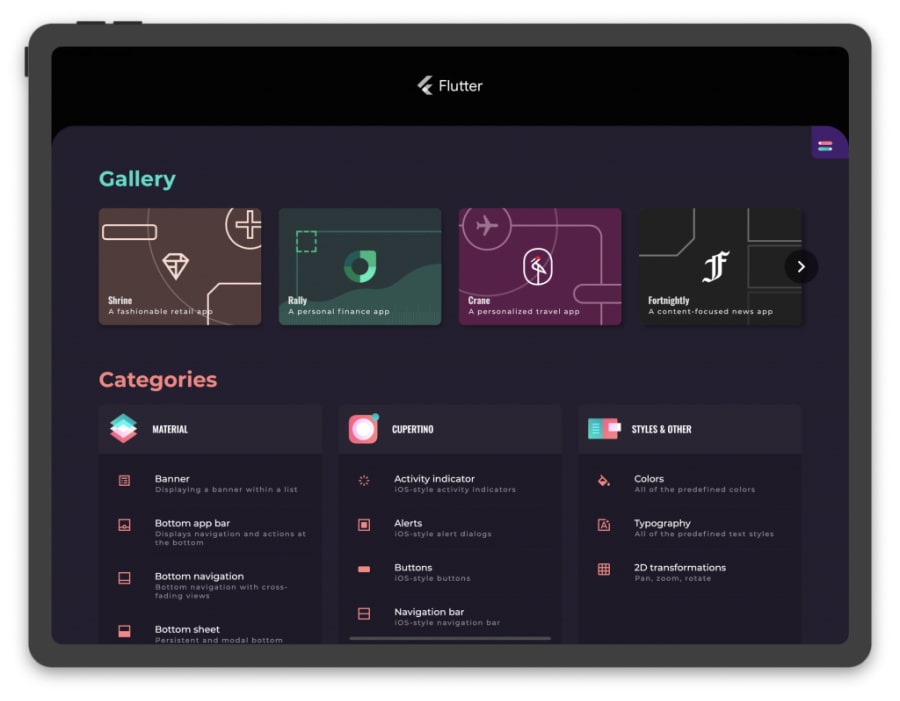
Flutter is quick and also gaining popularity. It runs on the Skia 2D graphics library, which also supports Chrome and Android. You may use Flutter if you want your visuals to run at the device’s native pace without any hiccups. The Dart platform, which powers Flutter, allows for translation to 32-bit and 64-bit ARM machine code for iOS and Android, in addition to JavaScript for the website and Intel x64 for pc platforms.
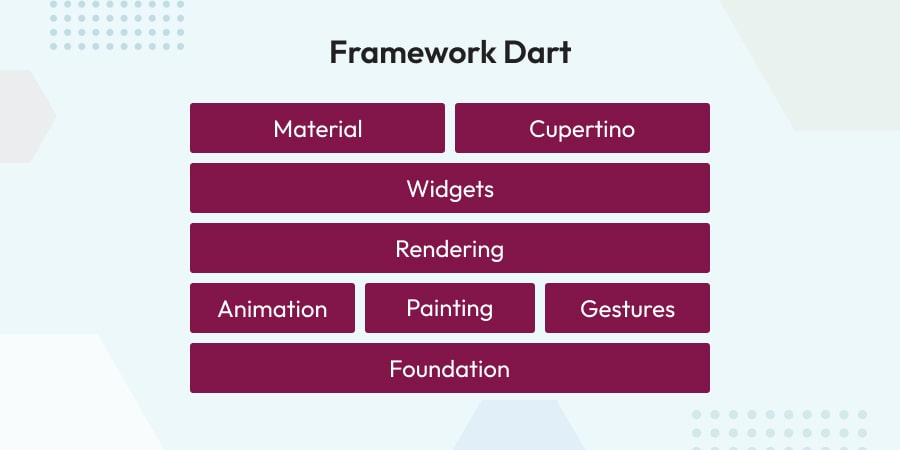
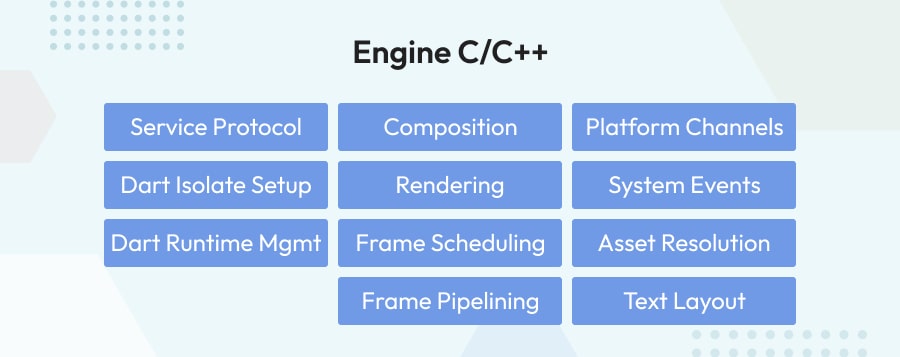

2. Features of Flutter
2.1 Hot Reload
Flutter’s lightning-fast speed is the key advantage of using this language. Flutter’s hot reload functionality lets you instantly see the effects of code changes on your testing device. When compared to alternative frameworks, this greatly improves the alignment of the development process.
2.2 Native Performance
You may use the Flutter libraries to gain accessibility to widgets that account for Android, iOS, and Google Fuchsia’s unique requirements. Consequently, all the platform-based capabilities of the app, such as clicking, browsing, buttons, and typefaces, may be integrated into the UI when using Flutter as a framework for UI creation.
And for those who want to create corporate apps for their company’s internal environment or a regional app, Flutter mobile app development offers a powerful native experience focused on the Android or iOS platforms.
It also facilitates the development of consistent, location-aware user interfaces. When using Flutter to create an app for a certain region, you may tailor the app’s user interface (UI) to the region’s chosen language, typography, and design.
2.3 Open-Source
Flutter is a new open-source platform that was released by Google. Developers working with Flutter have a lot of freedom to experiment with different layouts. Material Architecture and Cupertino plugins let developers make apps that are intuitive for their users. Flutter Form is a forum where users may ask and answer questions about the Flutter programming language. Flutter is open source, has extensive online information, and has active social networks.
2.4 Reactive User Interfaces
To update the interface at runtime as the program state shifts, Flutter is a responsive, pseudo-declarative UI framework. The programmer generates a mapping from application state to interface state, and the framework handles the rest. The Facebook React framework, which rethinks many established design ideas, served as inspiration for this model.
The default state of the user interface is defined once and then modified independently by user code at runtime in answer to actions in most conventional UI frameworks. The developer must be mindful of the ripple effect of state changes over the whole Interface, which becomes more difficult as the application’s complexity increases.
In contrast, Flutter and other reactive frameworks deliberately separate the UI from the app’s state to solve this issue. With React-like APIs, you only need to write the UI description once, and the framework will utilize that information to initialize and/or modify the UI as needed.
2.5 Widgets
Widgets serve as the primary building pieces for Flutter apps. They may be used to design UI elements like icons, labels, and text boxes for an app.
Widgets in Flutter are created with both the Cupertino design favored by Apple and the Material Design principles of Android in mind. These widgets make it easy to personalize the user interface, which is typically the slowest part of developing for several platforms.
3. What is Xamarin?
Xamarin is a free and open-source UI framework that extends the .NET platform with libraries and tools specifically for developing cross-platform mobile apps for iOS, watchOS, macOS, tvOS, Android, and Windows.
Xamarin.Forms will get you quickly up and rolling regardless of whether you want an uniform appearance throughout systems or desire a native style and appearance.
As mentioned earlier, Xamarin is a set of tools and frameworks for .NET developers that allows them to create programs for Multiple platforms, including Android, iOS, tvOS, watchOS, macOS, and Windows.
Xamarin Apps are truly native! Your apps will perform as expected regardless of whether you’re developing a cross-platform standard UI or a native UI.
Apps developed with Xamarin are produced for native efficiency, meaning they can take advantage of the platform’s unique hardware acceleration and access the entire range of features offered by the supporting platform and device. The diagram shows the overall architecture of a cross-platform Xamarin application. Xamarin allows you to create native UI on each platform and write business logic in C# that is shared across platforms. In most cases, 80% of application code is sharable using Xamarin.
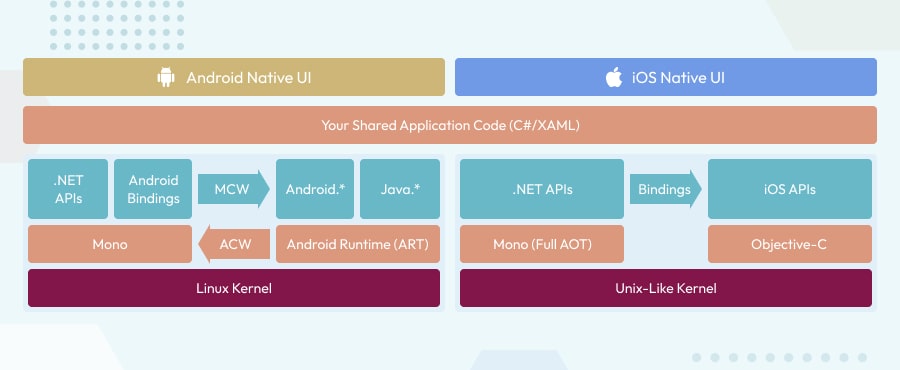
Xamarin is a tool utilized by thousands of developers all over the world, and it is a key component of the thriving .NET ecosystem. You may also utilize native APIs and 2D graphics with shared code using Xamarin’s robust libraries and your preferred frameworks and technologies.
Xamarin and .NET are used by organizations of all sizes and in all sectors to create high-quality native mobile applications.
4. Features of Xamarin
4.1 Based on .NET Framework
For building apps that run on several platforms, Xamarin employs a technical solution based on the usage of C# and native libraries covered in the .NET layer. These apps are frequently compared to their native counterparts on the iOS and Android mobile development platforms. Xamarin apps, for example, may take advantage of features like ARKit on iOS and Android Multi-Window by making use of all available native and the most up-to-date API access.
While Xamarin lets you reuse code for things like business logic, database access, and network connection across platforms, it also lets you write UI code that’s tailored to each one individually. So, as opposed to standard hybrid mobile apps, Xamarin cross-platform apps look and feel 100% native on every platform.
4.2 Mobile Cross-Platform Support
Xamarin provides excellent backing for developing apps that run across iOS, Android, and Windows. Approximately 90% code reuse is possible with Xamarin applications. Essentials provides a single API for getting at shared data across the three systems. By reusing existing code, mobile app creators may save time and money throughout the development process.
4.3 Xamarin.Forms
Xamarin.Forms is a standalone solution made so that app developers may use the same codebase for both iOS and Android. Basically, Xamarin.Forms was designed to accommodate Xamarin.Native which includes the strengthened capabilities of Xamarin.Android and Xamarin.iOS. It offers an overlay of the UI elements of the runtime environment and makes them available in a simple markup language.
4.4 Code Reusability
Sharing business logic throughout many mobile platforms is among the most fascinating features of using Xamarin as a cross-platform framework. Any code written in C# may be used on both Android and iOS with just minor modifications, allowing for significant code reuse. As a result, it speeds up development and requires less upkeep of the code.
In addition, Xamarin facilitates cross-platform project sharing when you’re using Microsoft Studio as your primary IDE. It also means that code may be easily transferred between projects by the developers. As an added bonus, Xamarin gives developers greater freedom to craft the user experience they want.
4.5 Compilation
Xamarin.iOS and Xamarin.Android are two of the platform’s primary solutions. Android Xamarin apps are initially converted down to Basic Syntax and then Translated into native assembly code at runtime, whereas iOS apps use Ahead-of-Time compilation to convert their source program code into native ARM assembly code which is Just-in-Time compilation. Memory allocation, trash collection, and cross-platform compatibility are automatically handled by the system as part of both of these implementations.
5. Flutter vs Xamarin: Key Differences
The need for mobile applications is growing rapidly. This is why the professionals look for a quick development framework to develop mobile applications. To create a quick app that offers many capabilities for designing e-commerce apps, dynamic apps, and social applications, many programmers have started adopting cross-platform development functionality.
Here, we’ll examine the key differences between Flutter and Xamarin to determine which framework is a better fit for your proposed project.
5.1 Popularity
There is a larger variety of projects that employ Xamarin than Flutter because it is much older and has been in the market for years unlike Flutter.
Before we delve deep into differences, let’s look at the Stack Overflow Trends of Flutter vs Xamarin for a clear distinction to their popularity. It shows that Flutter is far more popular than Xamarin. Flutter also ranked 2nd when programmers were polled about a tech they weren’t using but would be interested in learning to build apps for in the future.
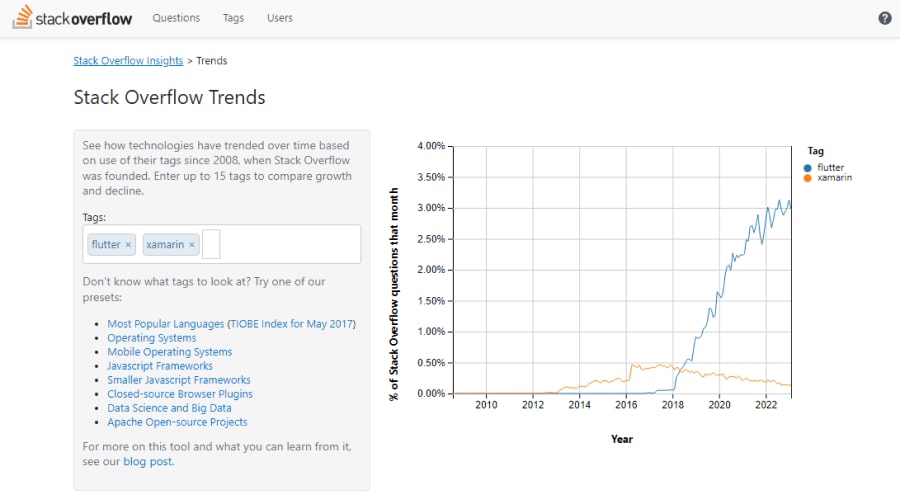
5.2 Installation
In contrast to Flutter, which can be installed with just a command line, Xamarin requires the Microsoft Studio IDE in order to be set up. It appears that adding the binaries to PATH and downloading it directly from the source code are both necessary for a successful Flutter installation. Flutter, on the other hand, requires no specific IDE for installation and has a far lower resource footprint.
5.3 Development Language
Since its beginnings, Xamarin has counted on the C# programming language to create its cross-platform software. Dart, a programming language created by Google in 2011 but rarely utilized by programmers, is the language used by Flutter. C# language’s longevity and Microsoft’s support have made it a widely used programming language. The global C# the development community is very large. Dart, on the other hand, has a lot to offer but is far less popular among programmers. With this, it’s evident that Xamarin is the superior programming language.
5.4 Performance
It has been said that Flutter’s performance vastly outperforms that of Xamarin apps. While Xamarin’s profiler can flag performance concerns sooner, this thread suggests that Flutter’s Dart engine is the better choice. Flutter’s hot reload functionality also greatly aids developers’ efficiency when making apps. When it comes to performance, Flutter gets a perfect score of ten.
5.5 Components
Flutter has excellent libraries of UI elements that adhere to the Material Design and Cupertino aesthetics. This streamlines the development process and takes aesthetic considerations into account for your app.
Nevertheless, Xamarin forms offer a complete cross-platform UI toolkit with UI components that look and behave like native components but are usable in environments where native components are not available.
If you’re ready to utilize them in your program, these parts are combined up to their native counterparts on the target platform. If you want more say over the look and feel of your app, Xamarin is worth a try.
Both frameworks compete well in terms of component support. Xamarin and Flutter are both excellent choices.
5.6 Community & Support
While deciding between competing frameworks, it is important to factor in the level of community support for each. It has tutorials for newcomers, a discussion board where experts may discuss tricky issues, and more.
Flutter has a robust community compared to other frameworks and languages. If you’re new to using Google Docs, you’ll find that it’s rather intuitive, and that there’s a wealth of knowledge available on public forums and websites like StackOverflow.
Xamarin has weaker support from the community. The caliber of the education offered by Microsoft’s free Xamarin courses and original approach falls short of what is required by Flutter.
6. Flutter vs Xamarin: Comparison Table
| Key Parameter | Flutter | Xamarin |
|---|---|---|
| Quick Overview | Flutter is a free and open-source UI library for building native apps for mobile, web, and desktop. It uses only a single set of codes and a single programming language to construct the whole app. | Xamarin is a free, cross-platform mobile development tool that may be used with iOS, Android, and Windows. The programmer just needs to create the code once and may then use it in other places. |
| Supported by | Google Inc. has backed it. | It has Microsoft’s support (since 2016). |
| Launch year | May 2017 | December 2012 |
| Language | Dart, a computer language developed by Google in 2011, is used to create mobile applications through Flutter. | C# and XMAL are the programming languages used to develop apps in this environment. |
| Installation | To utilize the Flutter framework, we must first obtain the platform-specific binaries from GitHub. A PATH variable pointing to the flutter.zip file must be set up before MacOS can be used. | Through the combination of the Visual Studio IDE and the Xamarin Software Development Kit, we may develop a Xamarin app. |
| App Size | Flutter apps are comparatively larger in size. It is a result of its use of app binaries. | Because of its compact binary size, the app size is comparatively small. |
| Performance | The Dart engine and the hot reload function contribute greatly to its remarkable efficiency. | The profiler revealed performance difficulties, explaining the sluggishness. |
| Testing Support | Among its many testing options is a novel take on the age-old problem of validating widgets. Further, it facilitates both unit and integration testing. | It’s compatible with a wide range of tests run in Visual Studio, from Unit tests to UI tests. In addition, the app is put through its paces utilizing a battery of third-party testing frameworks including Appium, XCUITest, and Expresso. In addition, it offers its own cloud testing platform. |
| Technical Architecture | To create mobile apps, Flutter makes use of the Dart programming language and the accompanying Dart engine, which includes features like Cupertino’s Material Design. It also makes use of the Skia C++ engine, which strictly adheres to all the standards, components, and channels. | For creating a program that can run on several platforms, it makes use of Mono. When developing for iOS, developers use this execution environment in tandem with the Objective-C runtime and the Unix kernel. When you develop for Android, you use the Android Runtime environment. |
| Documentation | It offers better documentation with all the information users need in one convenient location. | It provides developers with a comprehensive collection of resources, including a well-documented API. It has a wider range of platform compatibility than Flutter. |
| Community Support | Owing to the uniqueness of Flutter’s technology, consumer interest is currently low. Nevertheless, Google promotes it heavily, so it will likely explode in popularity next year. | Since C# has Microsoft’s backing, it enjoys widespread adoption and a large user base. |
| Hot Reload Feature | It’s useful since it allows you to use the Hot Reload function. | There’s no such thing as a “hot reload” in this system. However, it offers a wide variety of add-ons and a fantastic API for developers, all of which are reliant on the Visual Studio IDE. |
| User Interface | It has an excellent user Interface. | Since it generates output exclusively in HTML and CSS, the user experience is poor. |
| UI Elements | Widgets | Native Component |
| Reusability of the Code | Comparatively less | Comparatively High |
| IDE Support | Visual Studio, Android Studio, IntelliJ Idea. | Xcode, Visual Studio. |
| 3rd Party Library compatibility | High | Moderate |
| Popularity | High | High, But comparatively reducing |
| Price | Free | There are also not any licensing fees associated with Xamarin, including for commercial use. |
| Most Popular Apps | GPay, eBay Motors, Google Ads, etc. | UPS, World Bank, Alaska Airlines, etc. |
7. Conclusion
It’s a pleasure to deal with cross-platform frameworks. The value of being able to deliver code that runs smoothly on several platforms is hard to fathom until you actually use it.
When it comes to growing your business, cross-platform application development may be invaluable in helping you quickly and easily conquer new ground.
Identifying your needs and objectives is crucial when settling on a framework.
While in this comparative Flutter vs Xamarin guide, Flutter is a newcomer to the cross-platform game and Xamarin has been around for quite some time. An established framework like Xamarin has many advantages, yet Flutter remains competitive because of its dedicated user base.
The use cases, goals of the project, and needs will determine the ideal cross-platform framework for any development project. If forced to pick, many developers would pick Flutter over Xamarin. However, it all may depend on your project requirements.
UX is not the only aspect in determining the effectiveness of websites and mobile apps. A login form may seem like a little part of...
 Apr 10, 2023
Apr 10, 2023 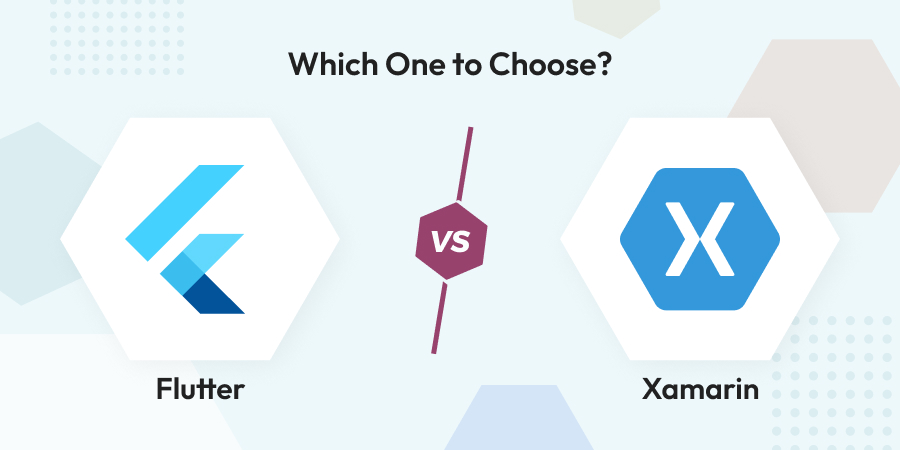
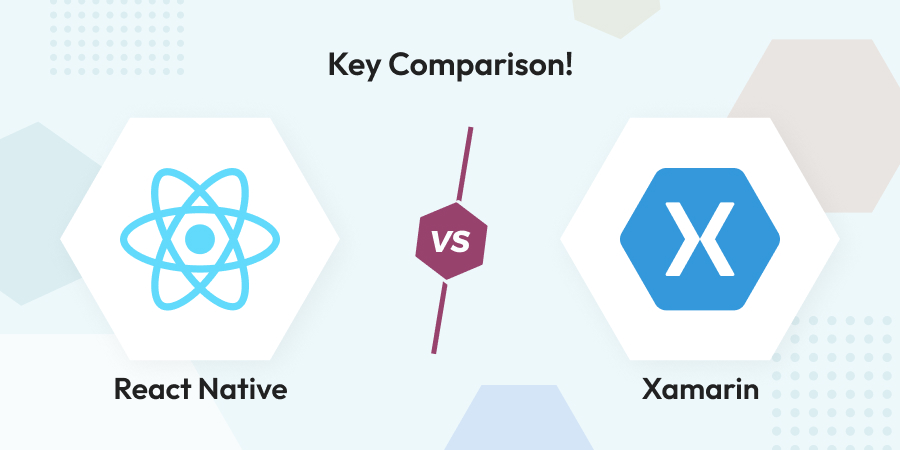
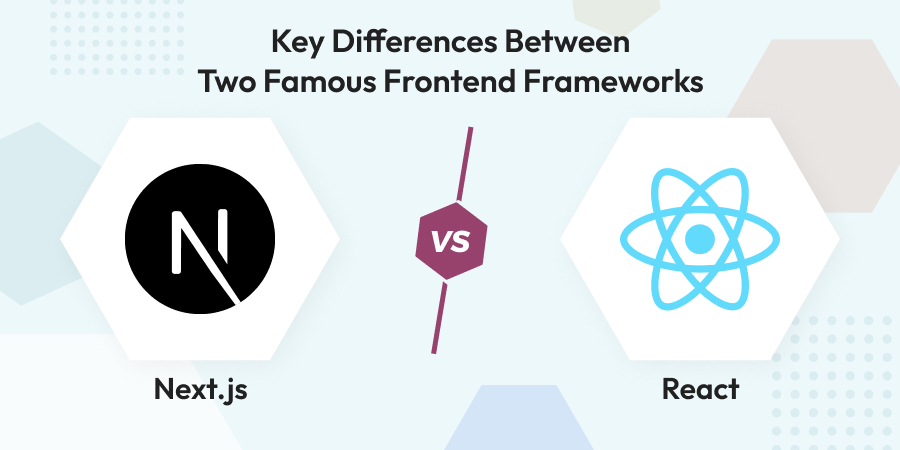
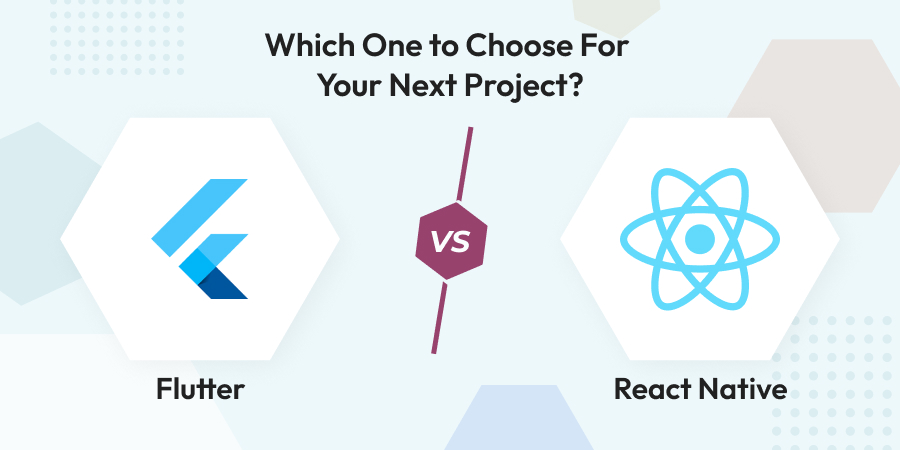
I've been following your technical blogs for a while now, and I'm always impressed by your content writing skills. Your topics are always interesting, and your writing is clear, concise, and engaging. I look forward to reading more of your work in the future!
There in no any clear winner between Flutter and Xamarin, it clearly depends on your specific needs and requirements. If you are looking for a framework that is high-performance, beautiful, and easy to learn, then Flutter is a good choice. If you are looking for a framework that is mature, stable, and has a large library of native controls, then Xamarin is a good choice.